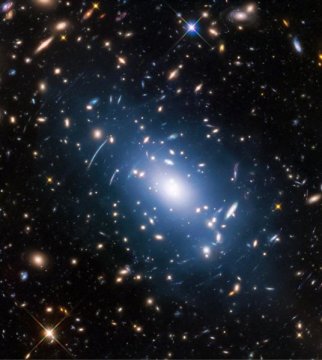[ad_1]
Astronomers using data from the NASA/ESA Hubble Space Telescope have employed a revolutionary method to detect dark matter in galaxy clusters. The method allows astronomers to “see” the distribution of dark matter more accurately than any other method used to date and it could possibly be used to explore the ultimate nature of dark matter. The results were published in the journal Monthly Notices of the Royal Astronomical Society.
In recent decades astronomers have tried to understand the true nature of the mysterious substance that makes up most of the matter in the Universe — dark matter — and to map its distribution in the Universe. Now two astronomers from Australia and Spain have used data from the Frontier Fields programme of the NASA/ESA Hubble Space Telescope to accurately study the distribution of dark matter.
“We have found a way to ‘see’ dark matter,” explains Mireia Montes (University of New South Wales, Australia), lead author of the study. “We have found that very faint light in galaxy clusters, the intracluster light, maps how dark matter is distributed.”
Intracluster light is a byproduct of interactions between galaxies. In the course of these interactions, individual stars are stripped from their galaxies and float freely within the cluster. Once free from their galaxies, they end up where the majority of the mass of the cluster, mostly dark matter, resides.
“These stars have an identical distribution to the dark matter, as far as our current technology allows us to study,” explained Montes. Both the dark matter and these isolated stars — which form the intracluster light — act as collisionless components. These follow the gravitational potential of the cluster itself. The study showed that the intracluster light is aligned with the dark matter, tracing its distribution more accurately than any other method relying on luminous tracers used so far.
This method is also more efficient than the more complex method of using gravitational lensing. While the latter requires both accurate lensing reconstruction and time-consuming spectroscopic campaigns, the method presented by Montes utilises only deep imaging. This means more clusters can be studied with the new method in the same amount of observation time.
The results of the study introduce the possibility of exploring the ultimate nature of dark matter. “If dark matter is self-interacting we could detect this as tiny departures in the dark matter distribution compared to this very faint stellar glow,” highlights Ignacio Trujillo (Instituto de Astrofísica de Canarias, Spain), co-author of the study. Currently, all that is known about dark matter is that it appears to interact with regular matter gravitationally, but not in any other way. To find that it self-interacts would place significant constraints on its identity.
For now, Montes and Trujillo plan to survey more of the original six clusters to see if their method remains accurate. Another important test of their method will be the observation and analysis of additional galaxy clusters by other research teams, to add to the data set and confirm their findings.
The team can also look forward to the application of the same techniques using future space-based telescopes like the NASA/ESA/CSA James Webb Space Telescope, which will have even more sensitive instruments able to resolve faint intracluster light in the distant Universe.
“There are exciting possibilities that we should be able to probe in the upcoming years by studying hundreds of galaxy clusters,” concludes Ignacio Trujillo.
Story Source:
Materials provided by ESA/Hubble Information Centre. Note: Content may be edited for style and length.
[ad_2]















